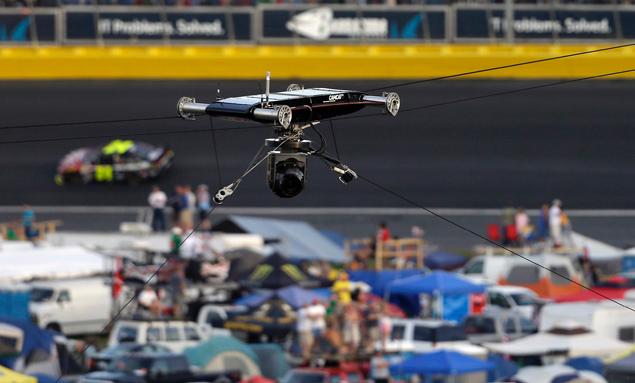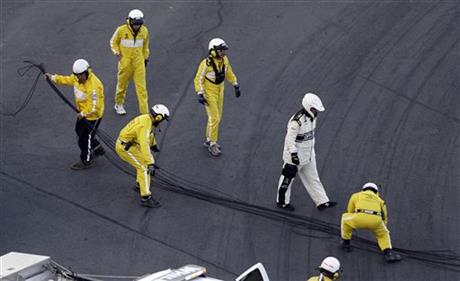When technology gets In the way
It’s become typical for digital production equipment to capture the action at live sports events from the behind the scenes, but last weekend at the 2013 Coca-Cola 600 NASCAR car race carried live on Fox Sports, the technology literally got in the way of the action.

It seems the tethered "cablecam" system that Fox Sports typically uses—and debuted only this year—malfunctioned during the race. One of the three cables (a Nylon rope) that suspends the camera over the track snapped in lap 121of the 400-lap NASCAR Sprint Cup race between turn #1 and 4 and landed on the track and the bottom rows of spectators. Ten fans were hurt, seven were treated for minor cuts and scrapes at on-site care centers and released. Three people were transported to an area hospital for further evaluation.
The rope was a guide for the overhead stabilized camera system.
The faulty cable, which is used to pull an HD camera along two guide wires at speeds up to 45 mph, is made of a synthetic material called Dyneema that those involved said is was supposed to be as strong as steel. Records show the cable had been factory-tested by the manufacturer before going in June 2012 to CAMCAT, the contractor (based in Austria) that operates the rig for Fox Sports. (CAMCAT systems are used in various industries.) Its breaking strength was certified at 9,300 pounds, Fox Sports said. During the race, the cable should not have encountered forces exceeding 900 pounds, but it broke none the less, causing the race to be halted and Fox Sports to publically state that it was suspending use of the cablecam system.
“At this time, we still do not have a cause for what happened, but a full investigation is underway, and use of the camera is suspended indefinitely,” Fox said in a statement. “"The camera itself did not come down because guide ropes acted as designed.”
Media reports quoted some of the drivers who were directly affected when the cable gave way, although no drivers were injured.
“It was like getting attacked by a giant squid,” Marcos Ambrose told the Charlotte Observer. The rope damaged his No. 9 Ford car. “It was just flapping, and I didn’t know what was going on.”
The professional video industry's #1 source for news, trends and product and tech information. Sign up below.
Kyle Busch’s No. 18 Toyota was also snared by the cable, which sliced into the body behind a tire. NASCAR officials allowed his crew to repair the damage during the race stoppage and he was able to continue (only to blow an engine later in the race).

"I just heard a big thunk on the right-front side tire and thought the right-front tire blew out," Busch told the Associated Press. “That's how hard it felt... It did have an effect slowing my car down and I could feel it like, 'Whoa, that's weird.' I don't know that anybody has ever seen that. Maybe now we can get rid of that thing.”
Therein lies the bigger problem. If technology gets in the way of the action, it won’t be used and that’s bad for everyone involved. That’s also a detriment of fans at home that are getting points of view they never could otherwise. Reliability and safety have to take precedence over anything else. Sometime, in the heat of creating these wiz-bang on-air effects, we as an industry need to remember that.
By the way, the race was won by Kevin Harvick, who said he wasn’t prepared to see the wayward TV cable dangling dangerously from above and wondered whether his vision was failing. “First time I drove by I said, my career is over … I saw this streak go by me. What … was that?” he recalled to the Charlotte Observer newspaper.
